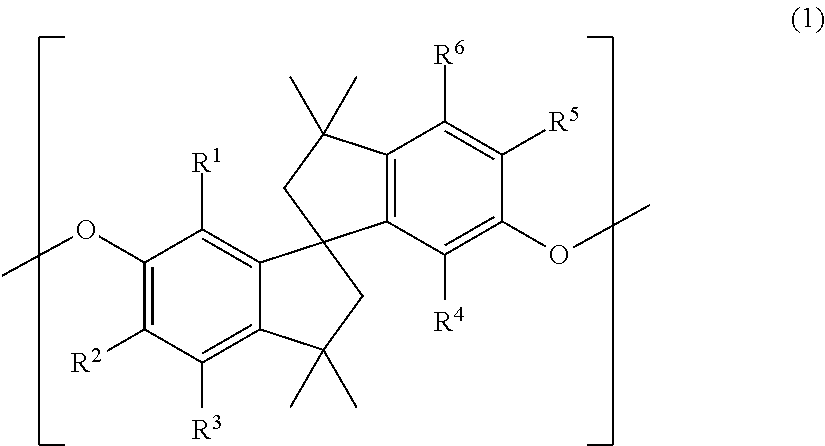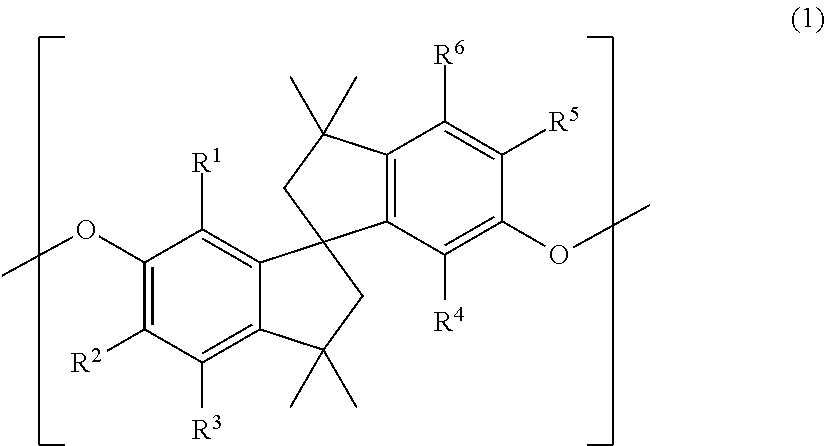Polycarbonate resin, molded article, and optical film
a technology of polycarbonate resin and molded articles, which is applied in the direction of instruments, polarising elements, optical elements, etc., can solve the problems of deformation of molded articles under high temperature, and achieve excellent heat resistance, heat resistance, and melt processability.
- Summary
- Abstract
- Description
- Claims
- Application Information
AI Technical Summary
Benefits of technology
Problems solved by technology
Method used
Image
Examples
example 1-1
[0375]18.45 parts by weight (0.060 mol) of SBI, 42.45 parts by weight (0.290 mol) of ISB, 25.42 parts by weight (0.176 mol) of CHDM, 115.05 parts by weight (0.537 mol) of DPC, and 1.86×10−3 parts by weight (1.05×10−5 mol) of calcium acetate monohydrate as a catalyst were charged in a reactor, and the inside of the reaction apparatus was purged with nitrogen under reduced pressure. The raw materials were dissolved with stirring in a nitrogen atmosphere at 150° C. for about 10 minutes. As a step of the first stage of the reaction, the temperature was elevated to 220° C. over 30 minutes, and the contents were allowed to react with each other at atmospheric pressure for 60 minutes. Subsequently, the pressure was reduced from the atmospheric pressure to 13.3 kPa over 90 minutes and held at 13.3 kPa for 30 minutes, and phenol generated was discharged out the reaction system. Subsequently, as a step of the second stage of the reaction, the pressure was reduced to 0.10 kPa or less over 15 m...
example 1-2
[0377]The synthesis was performed in the same manner as in Example 1-1, except for using 18.45 parts by weight (0.060 mol) of SBI, 42.45 parts by weight (0.290 mol) of ISB, 28.32 parts by weight (0.065 mol) of BHEPF, 90.65 parts by weight (0.423 mol) of DPC, and 1.10×10−3 parts by weight (6.22×10−6 mol) of calcium acetate monohydrate as a catalyst and setting the final polymerization temperature to 250° C., thereby obtaining pellets of a polycarbonate. The resulting polycarbonate pellets were used and subjected to the above-described various evaluations. The evaluation results are shown in Table 2.
(Evaluation Results for Application of Retardation Film)
[0378]The polycarbonate exhibited reverse dispersibility such that the wavelength dispersion (R450 / R550) was 0.98 and had high heat resistance (Tg) and low photoelastic coefficient. As compared with the case not using SBI (Comparative Example 1-8), the glass transition temperature could be improved while keeping the photoelastic coeff...
example 1-3
[0379]The synthesis was performed in the same manner as in Example 1-1, except for using 15.10 parts by weight (0.049 mol) of SBI, 53.87 parts by weight (0.369 mol) of ISB, 30.31 parts by weight (0.047 mol) of Compound 3, 80.21 parts by weight (0.374 mol) of DPC, and 1.10×10−3 parts by weight (6.26×10−6 mol) of calcium acetate monohydrate as a catalyst and setting the final polymerization temperature to 250° C., thereby obtaining pellets of a polyester carbonate. The resulting polyester carbonate pellets were used and subjected to the above-described various evaluations. The evaluation results are shown in Table 2.
(Evaluation Results for Application of Retardation Film)
[0380]The polyester carbonate exhibited had the wavelength dispersion (R450 / R550) of 0.85 and exhibited stronger reverse dispersibility than that in Example 1-2, and also had high heat resistance (Tg) and low photoelastic coefficient. In addition, as compared with the case not using SBI (Comparative Example 1-9), the ...
PUM
| Property | Measurement | Unit |
|---|---|---|
| glass transition temperature | aaaaa | aaaaa |
| glass transition temperature | aaaaa | aaaaa |
| glass transition temperature | aaaaa | aaaaa |
Abstract
Description
Claims
Application Information
 Login to View More
Login to View More - R&D
- Intellectual Property
- Life Sciences
- Materials
- Tech Scout
- Unparalleled Data Quality
- Higher Quality Content
- 60% Fewer Hallucinations
Browse by: Latest US Patents, China's latest patents, Technical Efficacy Thesaurus, Application Domain, Technology Topic, Popular Technical Reports.
© 2025 PatSnap. All rights reserved.Legal|Privacy policy|Modern Slavery Act Transparency Statement|Sitemap|About US| Contact US: help@patsnap.com



